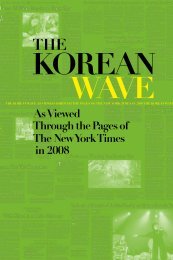The Korean Wave 2010-2011 - Korean Cultural Service
The Korean Wave 2010-2011 - Korean Cultural Service
The Korean Wave 2010-2011 - Korean Cultural Service
Create successful ePaper yourself
Turn your PDF publications into a flip-book with our unique Google optimized e-Paper software.
What the audience of 11,771 at PacificColiseum had witnessed was an unprecedentedcombination of technical difficultyand willowy sophistication as Kim became the firstSouth <strong>Korean</strong> skater to win an Olympic gold medal.She held up under enormous pressure to succeed as anathlete, a cultural icon and a vanquisher of competitorsfrom Japan, which occupied the <strong>Korean</strong> peninsula for35 years through the end of World War II.“Today, I was more confident than ever,” Kim, the2009 world champion, said.It is impossible to precisely compare skaters from differenteras. Rules change. Athleticism increasinglydemands its place alongside artistry. But a number ofKim’s gold medal predecessors were present Thursday,and all seemed thoroughly impressed that Kim hadbeen so poised and lissome in her presentation andvaulting in her jumps.“How do you compare that to Sonja Henie?” saidKristi Yamaguchi, the 1992 Olympic champion, referringto the three-time gold medalist from Norway inthe 1920s and ’30s. “Everything is relative to the timeand era.”Still, Yamaguchi added: “Certainly, it has taken women’sskating to another level. Technically. <strong>The</strong> wholepackage.”Assured, serene, Kim opened with a triple lutz-tripletoe combination, a triple flip and a double axel-doubletoe-double loop combination. Through four minutes ofthe challenging program, she skated with speed, lightnessand engaging openness in a style that her coach,Brian Orser, calls unselfish and welcoming.“She reaches the last row of the building,” Orser saidbeforehand. “People feel they’re invited to enjoy it asshe is.”On Thursday, Kim whisked like a feather across the ice.“Technically, she’s the greatest of all time,” said TedBarton, a Canadian who helped devise the new pointsbasedscoring system. “If she skates a little longer anddoes this over the next three or four years, she will bethe greatest skater of all time.”Scott Hamilton, the 1984 men’s Olympic champion,compared Kim to Seabiscuit, the thoroughbred, asdominant athletes who broke their competitors’ will.“Yu-na has only been at the top of her game for a coupleof years,” Hamilton said. “But if she’s here anotherfour years at this level, a lot of skaters would breakdown. <strong>The</strong>y would try to up their games so much, therewould be injuries. <strong>The</strong>re’s no weakness there. Compareher with anybody; she’s got it all. Under any system,anywhere, any time, she’d win.”Encomiums have been handed to Kim here in bouquets,like flowers. Michelle Kwan, the two-time Olympicmedalist, said, “She’s the fastest skater I’ve ever seen.”Katarina Witt, the 1984 and ’88 Olympic champion,said, “She has a lightness to her skating and her jumpsare very high.”Dorothy Hamill, the 1976 Olympic champion, said:“She’s the whole package. Her jumps are soaring andthey’re equal. You don’t have one big one followed by alittle tiny jump. I think she’s grown choreographically.She’s very musical. <strong>The</strong> whole thing is very beautifuland athletic, but not too athletic. I don’t feel like I’mmissing anything when I watch her.”Some believe that the new scoring system, with itsincessant technical demands on jumps and steps andspins, does not allow skaters the same charisma and signatureartistry afforded Peggy Fleming and Hamill andother stars from previous eras.“As far as being renowned as a legendary artist, I don’tthink so,” said Frank Carroll, who coached the fourthplacefinisher, Mirai Nagasu of the United States, ofKim. “As a really great skater, technically, yes.”David Kirby, an American coach and a technical expert,said: “Clearly, she’s the best girl, but it’s because she’sthe best technician. She’s 70 percent sport, 30 percentart. Peggy Fleming was a real artist and real athlete. Idon’t think that balance of art and sport is the Olympicchampion this year.”This will be seen as needless quibbling in South Korea,where Kim is the country’s most popular athlete. Sointense was the interest in the Kim-Asada rivalry that<strong>Korean</strong> reporters and photographers began arriving atthe arena 12 hours before Thursday’s competition, onlyto find that some of their Japanese counterparts hadspent the night at the rink.“This is not sports, this is war,” Lee Jiseok, a reporterfor the Daily Sports Seoul newspaper, said, laughing.He and his colleagues had already prepared stories onKim, her mother and her coach. “If she loses, we’redead,” Lee said. “We’ll have to explain why she lost.”That would not be necessary; Kim won the most glamorousevent at the Winter Games.“I think the whole nation is in front of the television,”said John Moon, chief of staff of the South <strong>Korean</strong>Olympic Committee. “Kim Yu-na is the country’s specialsister. Every athlete is important, but her medal ismore important than the others. She is beautiful. She’sour pride. I think <strong>Korean</strong>s will have a lot of drinks.”<strong>The</strong> New York Times, WEDNESDAY, APRIL 28, <strong>2010</strong><strong>Korean</strong> IsFirst Womanto Scale14 Highest PeaksBy CHOE SANG-HUNB13SEOUL, South KoreaClimbing on all fours after 13 grueling hours,a diminutive South <strong>Korean</strong> woman, OhEun-sun, reached the summit of one of theHimalayan giants on Tuesday to lay claim to being thefirst woman to scale the world’s 14 highest mountains.In keeping with her country’s intense pride in its athletes,she pulled out a South <strong>Korean</strong> flag, raised herarms and shouted: “Hurray! Hurray!”“I would like to share this joy with the South <strong>Korean</strong>people,” Oh, who is 5 feet 1 inch, said after reachingthe summit of Annapurna in central Nepal.South <strong>Korean</strong>s — who watched her climb because itwas broadcast live by an accompanying camera team— hailed her as a national hero.A message left on the Web site of the broadcaster KBSsaid: “All our people watched each step of your climb.You have demonstrated our country’s greatness all overthe world.”Annapurna was the last of the 14 peaks taller than26,247 feet (8,000 meters) that Oh needed to climbto make history. She reached the summit — 26,545feet above sea level — 13 years after she scaled her firstHimalayan mountain, Gasherbrum II, in 1997.“We recognize her achievement as the first woman climberto scale all the highest mountains in the world,” saidAng Tshering, president of the Nepal MountaineeringAssociation, according to <strong>The</strong> Associated Press.78 Copyright © <strong>2010</strong> by <strong>The</strong> New York Times Co. Reprinted with permission.79





